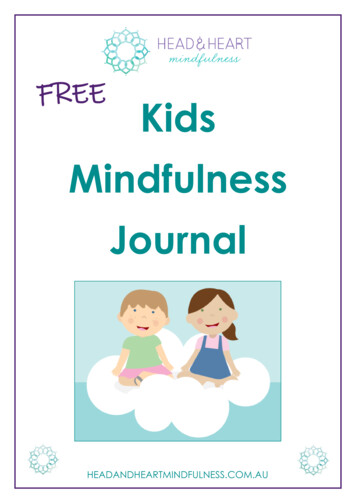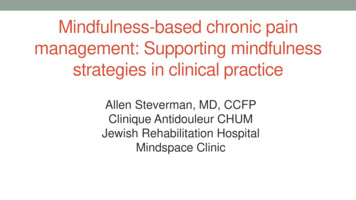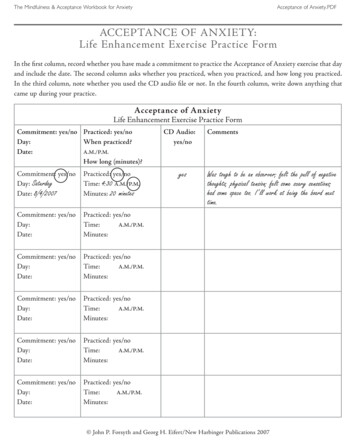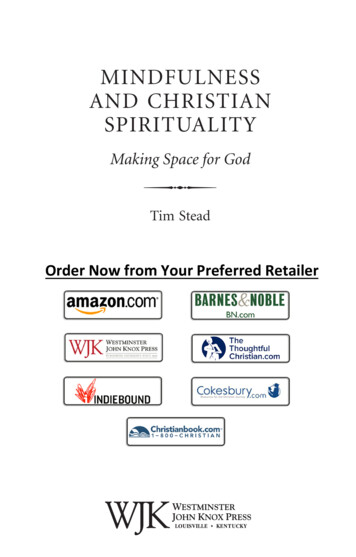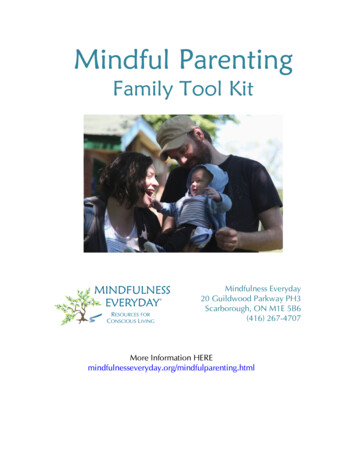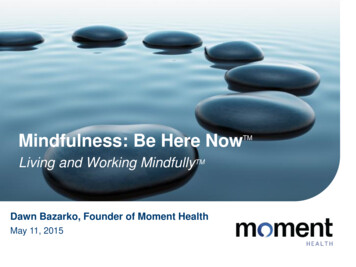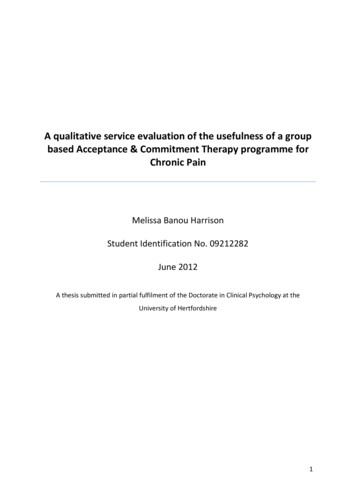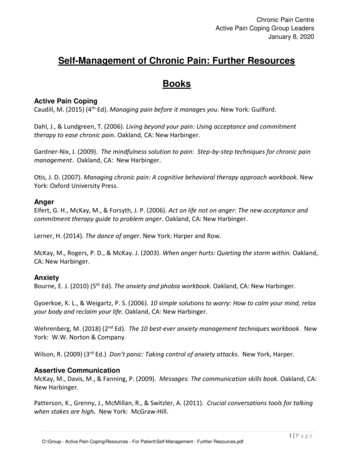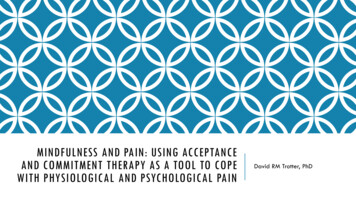
Transcription
MINDFULNESS AND PAIN: USING ACCEPTANCEAND COMMITMENT THERAPY AS A TOOL TO COPEWITH PHYSIOLOGICAL AND PSYCHOLOGICAL PAINDavid RM Trotter, PhD
“It is sometimes more important to know whatpatient has a disease than what disease apatient has”- William Osler
OBJECTIVES Describe the differences between the biomedical and the ACT definitions of pain Discuss the differences between psychological inflexibility and flexibility Practice basic ACT skills based on an understanding of the “Hexaflex”
OVERVIEW1. Background and definitions2. Psychological flexibility3. ACT based skills
WHAT IS CHRONIC PAINAcute Pain Pain lasting less than 3-6 monthsChronic Pain: Pain lasting more than 3-6 months Chronic pain may be caused by an initial injury (e.g. back injury, sprain, illness); however, there may beno clear cause(NIH, 2011)
PAIN AND PUBLIC HEALTHPain 50 million Americans struggle with pain Pain is involved in about 80% of all doctors visits 150 billion in direct health care costsChronic pain is a serious public health concern Point prevalence: 10-20% of the US population Accounts for about 15% of all lost work days Accounts for about 18% of early retirements(Gatchel, 2007; Pfingsten & Hidebrandt, 2004; van Hecke, Torrance, & Smith, 2013)
PAIN PSYCHIATRIC COMORBIDITYDepression: 30-54% of those with chronic pain also meet criteria for a depressivedisorder.Anxiety Disorders: Higher rates of PTSD, Panic Disorder, and Agoraphobia amongthose with chronic painSuicide: 4-5x increase in SI with abdominal pain, but decreased SI with neuropathicpain (likely associated with an identifiable disease process).Substance use Disorders among those receiving opiate treatments (CLBP): Current23%, Lifetime- 54%Aberrant Drug Behaviors: 5 -24%(Martell et al., 2007; Sharp J. & Keefe B., 2006)
TYPICAL RESPONSES TO PAINAcute PainActs as a biological warning that signals biological harm, increases awareness, and calls foractionTypical Response: Avoidance of pain, rest, care seeking, limit movementChronic PainActs as a signal of harm in the same way that acute pain does.Typical Response: Same as acute painThe Problem: We are programed to respond adaptively to acute pain, but not chronic pain
TYPICAL RESPONSES TO PAINProblems with responding to acute and chronic pain in the same ways There is often no “fix” for chronic pain so care seeking behaviors can becomemaladaptive (e.g. doctor shopping, sick role becomes part of identity)Patients are looking for a medical remedy, and can reject other effective modalitiesAvoidance and rest leads to deconditioning, which can exacerbate pain anddysfunctionWhile opiates are extremely effective for acute pain, they can cause tolerance,dependence, and even hyperalgesia when used for chronic pain
ACT: PAIN VS. SUFFERINGPain Suffering
ACT Model of Human Suffering
ACT Hexaflex
PAST/FUTURE FOCUS VS PRESENT MOMENTAWARENESS“Reliving” the past, how we have conceptualized itTrying to “figure out” why things have happened the way they didWishing that we could “change” what we or another didFantasizing about the futureWorrying about what might happenPlanning
PAST/FUTURE FOCUS VS PRESENT MOMENTAWARENESSTo be psychologically present: consciously connected with and engaged in what everis happing in the moment, in both physical and psychological worlds. (Harris, 2009)Key elements: Commitment to focus Moment-to-moment orientation Nonjudgmental stance“Mindful Breathing”
AVOIDANCE VS ACCEPTANCEExperiential Avoidance is trying to get rid of all of the “unwanted” stuff we carryinside our skin. This can include psychological (e.g. memories, feelings, thoughts) orphysical (e.g. pain, discomfort) experiences.Experiential Acceptance is when we “open up” or “make space” for all the unwantedinternal experiences. This allows us to “drop the struggle” with these experiences,freeing us to do something else.
ACCEPTANCE ROLE PLAYSTug-of-war
COGNITIVE DEFUSION ROLE PLAYSDeliteralization Exercises Lemon Exercise
FUSION VS DEFUSIONCognitive Fusion: Entanglement with our thoughts, memories, and images so that theydominate our awareness and drive our awareness.Cognitive Defusion: Take a step back, and get some space between you and yourthoughts, images, memories, and sensations. Get some “breathing space,” so that youcan choose to behave in different ways.
CONCEPTUALIZED SELF VS SELF-AS-CONTEXTConceptualized Self, or Self-as-Content: When we hold onto the stories or our lives sotightly that we fail to notice that we are not in fact the story. When we view thecontent of our thoughts, memories, images as being who and what we are.Self-as-Context, or Pure Awareness: The unchanging part of everyone that canobserve what is happening. The difference between the “thinking self” and the“observing self.” This is the part of you than can engage in tasks like “metacognition.”“Chess Game”
UNDEFINED VALUES VS DEFINED VALUESUndefined Values: Loosing touch with what is important to you, and basing yourbehavior more on avoidance and fusion than on anything else.Defined Values: Knowing what matters most to you. Knowing your desired qualities ofbehavior. Not to be confused with “goals.”
UNWORKABLE ACTION VS COMMITTED ACTIONUnworkable Action, or Unworkable Agenda: When our patterns of behavior aredriven by avoidance of what we have in the moment. This can take the form of manypathological behaviors including drugs/EtOH, isolation, impulsive or risky actions,suicide attempts, seeking counseling, and so on.Committed Action: When our patterns of behavior are consistently and effectivelymoving us toward our declared values. In other words, doing what is important to us,even if our minds tell us that we don’t “feel” like it.“Quicksand Metaphor”“Perfect Anxiety Machine”
LETS TRY SOME MORE!“Physicalizing”“Body Scan”“Grounding”
QUESTIONS?
BIOPSYCHOSOCIAL MODEL:THE VIEW FROM 30,000 FEETHow you care for patients depends on how you understandhealth and human problemsBiomedical Model Assumptions1.2.Biological Reductionism: health problems are only explainable by analysis and reduction tosmaller cellular and molecular parts.Dualism: The mind and body are separate and distinct entities.
BIOPSYCHOSOCIAL MODEL:THE VIEW FROM 30,000 FEETNatural Consequences of the biomedical model: “Magic bullet solutions”“Cures”A drive to be “right”Discomfort with uncertaintyA tendency to ignore the “noise”Increased healthcare costs
BIOPSYCHOSOCIAL MODEL:THE VIEW FROM 30,000 FEETBiopsychosocial Model Assumptions General Systems Theory: Assumes a complex, reciprocal relationship between the mind and body; aholistic perspective; health problems are at once a biological, psychological, and social experience(Engel, 1977)
BIOPSYCHOSOCIAL MODEL:THE VIEW FROM 30,000 FEETNatural Consequences of the biopsychosocial model: Complex problems need complex solutions“Noise” becomes dataIncreased comfort with uncertaintyKnowledge that you do not have the “right” answer
MINDFULNESS AND PAIN: USING ACCEPTANCE AND COMMITMENT THERAPY AS A TOOL TO COPE WITH PHYSIOLOGICAL AND PSYCHOLOGICAL PAIN David RM Trotter, PhD "It is sometimes more important to know what patient has a disease than what disease a patient has" - William Osler. OBJECTIVES


